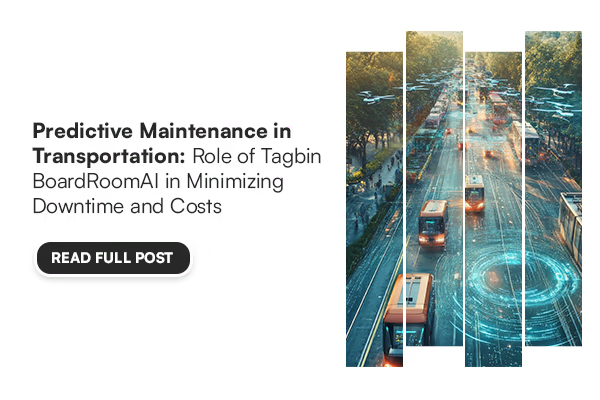Have you ever wondered what it would take to prevent a vehicle breakdown before it happens? For the transportation industry, ensuring that fleets run smoothly is more than just a matter of convenience—it’s critical to minimizing downtime, cutting costs, and maintaining efficiency. Imagine if transportation companies could predict when a part is likely to fail and take action before it does. This is where predictive maintenance, powered by AI technology Tagbin BoardRoomAI, comes into play.
In today’s fast-paced, interconnected world, downtime in transportation can be incredibly costly. Whether it’s a delivery truck or a passenger bus, any delay can lead to lost revenue, dissatisfied customers, and wasted resources. Fortunately, predictive maintenance is emerging as a solution to these challenges by enabling real-time monitoring, early detection of problems, and proactive maintenance scheduling.
Let’s explore how Tagbin BoardRoomAI is shaping the future of transportation by helping minimize both downtime and costs through predictive maintenance.
What is Predictive Maintenance in Transportation?
Predictive maintenance in transportation uses data analytics, machine learning, and IoT sensors to monitor the condition of vehicles and equipment in real-time. Unlike traditional maintenance strategies—where parts are fixed after failure (reactive maintenance) or at predetermined intervals (preventive maintenance)—predictive maintenance relies on actual data about the wear and tear of parts to predict when they are likely to fail.
How Tagbin BoardRoomAI Powers Predictive Maintenance?
Tagbin BoardRoomAI leverages cutting-edge AI technology to enhance predictive maintenance strategies in the transportation sector.
Here’s how Tagbin BoardRoomAI stands out in this domain:
Real-Time Data Analysis
Tagbin BoardRoomAI uses real-time data to continuously monitor the performance metrics of the fleet. The system collects vast amounts of data and uses machine learning algorithms to analyze patterns and anomalies, allowing it to detect when something is off and predict potential issues.
AI-Powered Decision-Making
Once a potential issue is identified, the AI-powered platform can make recommendations based on historical data and predictive models. For example, if the system detects unusual performance of a transporting vehicle that typically precedes a component failure, it will flag the issue and recommend that maintenance be performed soon, rather than waiting for the part to fail. This intelligent decision-making minimizes downtime and ensures that repairs are performed at the most cost-effective time.
Optimizing Maintenance Schedules
One of the key advantages of predictive maintenance powered by Tagbin BoardRoomAI is the ability to optimize maintenance schedules. Instead of adhering to rigid maintenance intervals, transportation companies can schedule maintenance when it is truly necessary, reducing unnecessary servicing and associated costs. This not only increases the efficiency of the maintenance team but also keeps vehicles in service for longer, improving overall fleet availability.
Reducing Inventory
Predictive maintenance is more precise in identifying when parts need to be replaced, companies can reduce the need for large spare parts inventories. With AI accurately predicting which components will fail and when, companies can order parts just in time, avoiding the costs associated with stocking and managing surplus inventory.
The Benefits of Minimizing Downtime with Predictive Maintenance
Minimizing downtime is one of the most critical factors in maintaining the smooth operation of any transportation network. Here are some of the key benefits that predictive maintenance, powered by Tagbin BoardRoomAI, offers to transportation companies:
Lower Maintenance Costs
Unplanned downtime can be incredibly costly—not just in terms of repair expenses, but also in lost revenue and productivity. Predictive maintenance minimizes the risk of unexpected breakdowns, allowing companies to schedule maintenance during non-operational hours and reduce the likelihood of costly repairs.
Extended Equipment Life
By addressing potential issues early, predictive maintenance helps extend the life of vehicle components. Regular, data-driven maintenance ensures that vehicles are operating under optimal conditions, reducing wear and tear and delaying the need for expensive replacements.
Improved Safety
Safety is paramount in the transportation industry. Mechanical failures can lead to accidents or hazardous situations for drivers and passengers. Predictive maintenance reduces the chances of equipment failure while on the road, ensuring that vehicles remain safe and roadworthy.
Increased Fleet Availability
For transportation companies, keeping vehicles on the road as much as possible is essential to maximizing revenue. Predictive maintenance allows for better scheduling of repairs and minimizes the time vehicles spend out of service. This improved fleet availability translates into more efficient operations and higher profits.
Conclusion
As we move into a future increasingly shaped by AI, predictive maintenance will become the standard approach for managing transportation fleets. With solutions like Tagbin BoardRoomAI, transportation companies are already witnessing the immense benefits of this technology. By minimizing downtime and reducing maintenance costs, AI-powered predictive maintenance is helping transportation companies become more efficient, safe, and profitable. The future of transportation is here, and it’s powered by Tagbin BoardRoomAI.




